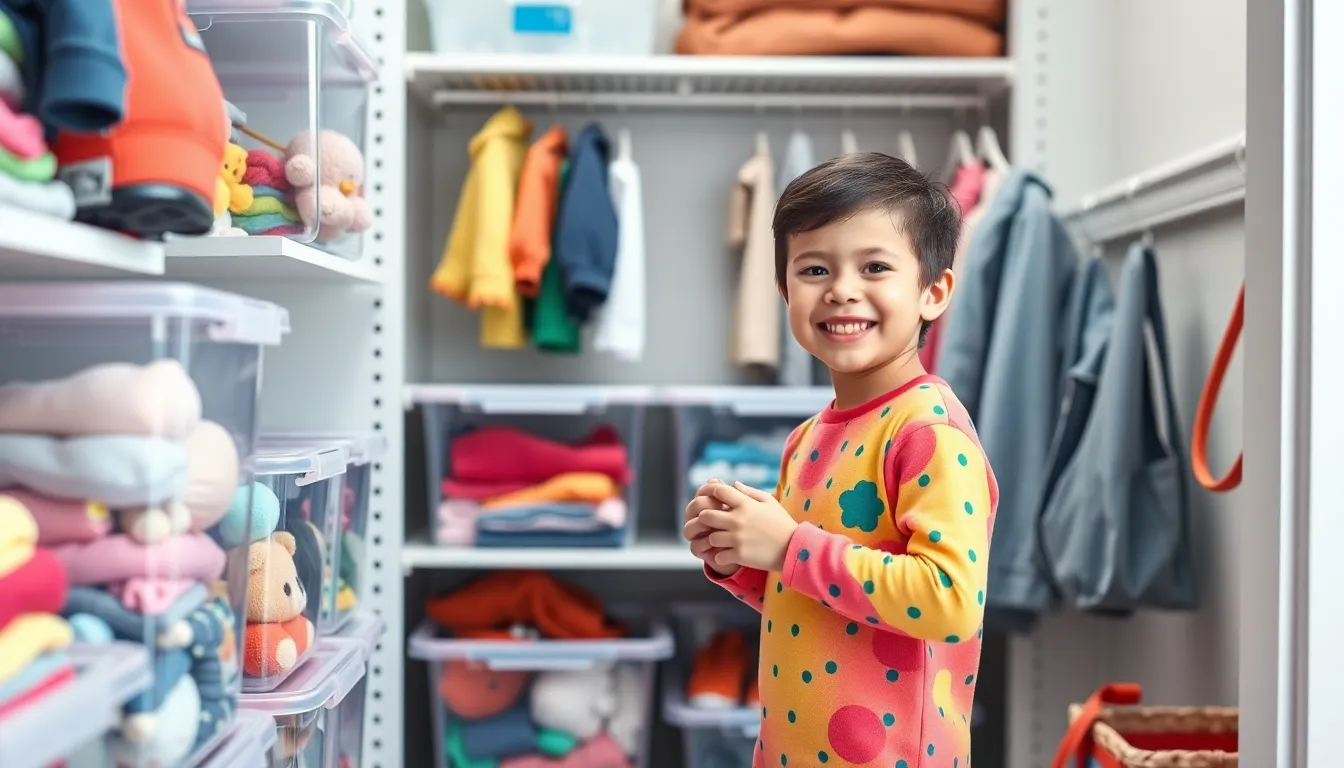Table of Contents
ToggleTransforming a chaotic kids’ closet into an organized wonderland sounds like a daunting task, but it doesn’t have to be. With a sprinkle of creativity and a dash of DIY spirit, anyone can turn that messy space into a functional haven for tiny clothes and even tinier shoes. Imagine the joy of opening a closet that not only looks great but also makes finding outfits a breeze—no more digging through piles of clothes like a treasure hunt gone wrong!
Benefits Of A DIY Kids Closet
A DIY kids closet offers multiple advantages that significantly enhance organization and space utilization. Each benefit contributes to a more enjoyable and functional area for both kids and parents.
Organization
Creating a DIY kids closet improves overall organization. Specific storage solutions, such as labeled bins and adjustable shelves, facilitate easier access to items. With designated spaces for clothes, shoes, and toys, children learn to locate their belongings independently. Streamlining the storage process reduces clutter, maintaining a tidy appearance. Regularly organized systems support faster dressing routines and promote responsibility. Parents can quickly assess what clothing fits and what needs replacement. Overall, enhancing organization allows for a more efficient daily routine.
Customization
Customization plays a vital role in a DIY kids closet. Unique designs can cater to individual preferences and specific needs. Color schemes and themes make the space inviting, reflecting a child’s personality. Custom shelving heights allow kids to reach their belongings easily. Adjusting organization methods to accommodate growth is also achievable with a DIY approach. Choosing sustainable materials or eco-friendly products adds to the project’s value. Tailored solutions promote a sense of ownership, encouraging kids to take pride in their closet. Customization ultimately provides a functional and aesthetically pleasing environment.
Essential Materials For Building A DIY Kids Closet

Creating a DIY kids closet requires essential materials to ensure durability and functionality. Gathering these materials simplifies the process and enhances the final outcome.
Storage Solutions
Utilizing bins makes organizing clothes and toys straightforward. Choose clear plastic bins for visibility, enabling quick identification of contents. Labeled baskets facilitate easy access, helping children learn to locate items independently. Adjustable shelves provide flexibility for growth, accommodating clothes and accessories as kids age. Incorporating hooks for bags and outerwear saves space while promoting organization. Finally, a small dresser integrates additional storage for smaller items, ensuring everything has a designated place.
Tools Needed
Having the right tools streamlines the building process. Use a measuring tape to ensure accurate dimensions and fit. A level ensures that shelves align perfectly, avoiding future imbalance. Invest in a power drill for efficient assembling, particularly with screws. A saw may be necessary for cutting wood to specific sizes, ensuring a custom fit. Additionally, a screwdriver assists in securing components effectively. Lastly, safety goggles guarantee protection during any cutting or drilling tasks.
Step-By-Step Guide To Create A DIY Kids Closet
Creating a DIY kids closet involves careful planning and a systematic installation process. Both steps lead to a functional and visually appealing space.
Planning The Layout
Measure the closet dimensions accurately. Effective layouts utilize available space efficiently, ensuring all items store neatly. Sketch a design that includes shelving heights catering to a child’s reach. Prioritize accessibility by placing frequently used items at eye level. Incorporate floor space for bins or baskets, enhancing storage versatility. Consider including hooks for accessories or bags, promoting organization. Identify zones within the closet, such as clothing, shoes, and toys, to simplify the selection process.
Installation Process
Start by gathering all materials before beginning. Assemble the necessary tools, including a power drill, level, and measuring tape. Secure shelving brackets into wall studs for stability. Install adjustable shelves at designated heights according to the layout plan. Introduce labeled baskets or bins, placing them on lower shelves for easy access. Use hooks to hang items, ensuring each item has a proper spot.
Finally, check the entire setup for balance and functionality. Adjust as needed to enhance usability and ensure everything fits snugly in the closet space.
Creative Ideas For A DIY Kids Closet
Creating a DIY kids closet offers endless possibilities for customization and organization. Here are some creative ideas to inspire the transformation.
Themed Decor
Incorporating a theme can make the closet more engaging. Consider using color schemes inspired by a child’s favorite character or activity, such as space or animals. Wall decals featuring stars or jungle animals add visual interest. Incorporating themed bins or baskets that match the decor enhances the overall aesthetic while maintaining functionality. Personalized touches, like a name plaque or framed artwork, create a sense of belonging. Bright lighting or fun drawer pulls can also elevate the ambiance, making it a vibrant space for kids.
Functional Features
Functionality is crucial in a DIY kids closet. Adjustable shelving allows for growth as clothing sizes change. Utilizing pegboards for hanging items promotes easy access and organization. Introducing multi-tiered hooks can accommodate bags, hats, and accessories, keeping them off the floor. Adding a small stool or step ladder enables kids to reach high shelves independently. Clear bins with labels provide visibility, making it easy to find items quickly. Each feature serves a purpose, enhancing the overall efficiency of the closet.
Maintenance Tips For A DIY Kids Closet
Maintaining an organized DIY kids closet requires consistent attention and regular updates to keep it functional and appealing. These simple maintenance tips make a significant difference in sustaining a tidy space.
Regular Cleaning
Cleaning the closet frequently prevents clutter from accumulating. A quick weekly check involves removing items that don’t belong, such as toys or outgrown clothes. Organizing items by category streamlines the selection process for children. Labeling bins aids kids in returning items to their proper places. During cleaning sessions, parents should encourage children to participate, fostering responsibility and ownership of their space.
Seasonal Updates
Updating the closet seasonally keeps the organization relevant. Assessing clothing and accessories during seasonal transitions is essential. Parents can remove outgrown items and donate those in good condition, making space for new additions. Adjusting the height of shelves accommodates growing children and changing needs. Explaining these adjustments to kids promotes understanding and cooperation, ensuring they stay engaged with their closet organization.
Transforming a kids’ closet into an organized space is not just a project; it’s an investment in a child’s independence and responsibility. With the right approach and creativity, parents can create a functional area that reflects their child’s personality while promoting organization.
The satisfaction of a tidy closet can lead to quicker dressing routines and a sense of pride in ownership. By involving children in the process and maintaining the space regularly, families can cultivate lasting habits that benefit everyone. Ultimately, a DIY kids closet becomes more than just storage; it becomes a vibrant part of a child’s daily life.




